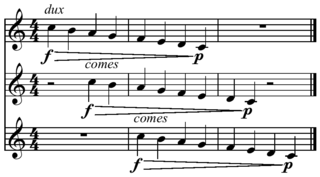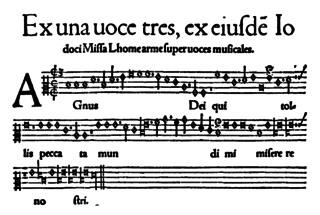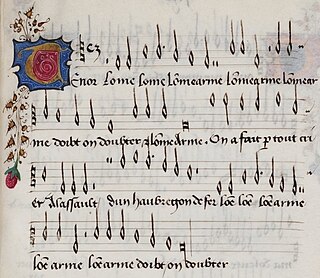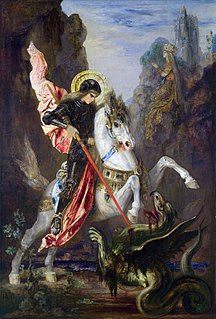
The Mass, a form of sacred musical composition, is a choral composition that sets the invariable portions of the Eucharistic liturgy to music. Musical Masses take their name from the Catholic liturgy called "the Mass".

Johannes Ockeghem was the most famous composer of the Franco-Flemish School in the last half of the 15th century, and is often considered the most influential composer between Guillaume Dufay and Josquin des Prez. In addition to being a renowned composer, he was also an honored singer, choirmaster, and teacher.

In music, a canon is a contrapuntal (counterpoint-based) compositional technique that employs a melody with one or more imitations of the melody played after a given duration. The initial melody is called the leader, while the imitative melody, which is played in a different voice, is called the follower. The follower must imitate the leader, either as an exact replication of its rhythms and intervals or some transformation thereof. Repeating canons in which all voices are musically identical are called rounds—"Row, Row, Row Your Boat" and "Frère Jacques" are popular examples.
Antoine Brumel was a French composer. He was one of the first renowned French members of the Franco-Flemish school of the Renaissance, and, after Josquin des Prez, was one of the most influential composers of his generation.

Jacob Obrecht was a Flemish composer of masses, motets and songs. He was the most famous composer of masses in Europe of the late 15th century and was only eclipsed after his death by Josquin des Prez.

In music, a prolation canon is a type of canon, a musical composition wherein the main melody is accompanied by one or more imitations of that melody in other voices. Not only do the voices sing or play the same melody, they do so at different speeds. Accompanying voices may enter either simultaneously or successively. If voices extend the rhythmic values of the leader, a procedure known as augmentation, the resulting canon can be called an augmentation canon or canon by augmentation or sloth canon. Conversely, if they reduce the note values in diminution, it can be called a diminution canon or canon by diminution.

Pierre de la Rue was a Franco-Flemish composer and singer of the Renaissance. His name also appears as Piersson or variants of Pierchon and his toponymic, when present, as various forms of de Platea, de Robore, or de Vico. A member of the same generation as Josquin des Prez, and a long associate of the Habsburg-Burgundian musical chapel, he ranks with Agricola, Brumel, Compère, Isaac, Obrecht, and Weerbeke as one of the most famous and influential composers in the Netherlands polyphonic style in the decades around 1500.

"L'homme armé" is a Burgundian School secular song from the time of the Late Middle Ages. According to Allan W. Atlas, "the tune circulated in both the Mixolydian mode and Dorian mode ." It was the most popular tune used for musical settings of the Ordinary of the Mass: over 40 separate compositions entitled Missa L'homme armé survive from the period.
In Renaissance music, the cyclic mass was a setting of the Ordinary of the Roman Catholic Mass, in which each of the movements – Kyrie, Gloria, Credo, Sanctus, and Agnus Dei – shared a common musical theme, commonly a cantus firmus, thus making it a unified whole. The cyclic mass was the first multi-movement form in western music to be subject to a single organizing principle.

The Missa Caput was a musical setting of the Roman Catholic mass, dating from the 1440s, by an anonymous English composer. It circulated widely on the European continent in the mid-15th century and was one of the best-loved musical works of the early Renaissance in Europe, judging by the number of copies that have survived, and the number of imitations it inspired. It was influential both for its use of a tenor cantus firmus which unified all the movements and for being the first extended composition with a freely composed bass line, a feature with extraordinary ramifications in music history. Among the many composers influenced by it are Guillaume Du Fay and Johannes Ockeghem.
Petrus de Domarto was a Franco-Flemish composer of the Renaissance. He was a contemporary and probable acquaintance of Ockeghem, and was the composer of at least one of the first unified mass cycles to be written in continental Europe.
Requiem, by Johannes Ockeghem, is a polyphonic setting of the Roman Catholic Requiem Mass. It is probably the earliest surviving polyphonic setting of any requiem mass. It is unusual in that the movements vary greatly in style, and each uses a paraphrase technique for the original Sarum chant. It has five parts for four voices and is one of Ockeghem's best known and most performed works.

The Missa L'homme armé super voces musicales is the first of two settings of the Ordinary of the Mass by Josquin des Prez using the famous L'homme armé tune as their cantus firmus source material. The setting is for four voices. It was the most famous mass Josquin composed, surviving in numerous manuscripts and print editions. The earliest printed collection of music devoted to a single composer, the Misse Josquin published by Ottaviano Petrucci in 1502, begins with this famous work.

The Missa de Beata Virgine is a musical setting of the Ordinary of the Mass, by Renaissance composer Josquin des Prez. A late work, probably composed or assembled around 1510, it was the most popular of his masses in the 16th century.
The Missa Sine nomine is a setting of the Ordinary of the Mass by Renaissance composer Josquin des Prez. It is a work of his maturity, probably dating from the period after he returned to Condé-sur-l'Escaut in 1504. It is one of Josquin's only masses not to be based on pre-existing material, and like the Missa ad fugam, it is a canonic mass.
A Missa sine nomine, literally a "Mass without a name", is a musical setting of the Ordinary of the Mass, usually from the Renaissance, which uses no pre-existing musical source material, as was normally the case in mass composition. Not all masses based on freely composed material were so named, but many were, particularly from the late 15th century through the 16th century.
Marbrianus de Orto was a Dutch composer of the Renaissance. He was a contemporary, close associate, and possible friend of Josquin des Prez, and was one of the first composers to write a completely canonic setting of the Ordinary of the Mass.
Jehan Fresneau was a French composer of the Renaissance. He was one of the composers in the renowned Milan chapel in the mid-1470s, which was disbanded after the assassination of Duke Galeazzo Maria Sforza.
Missa Cuiusvis Toni is a four-part musical setting of the Ordinary of the Mass by the 15th-century composer Johannes Ockeghem. It is found in late-century manuscripts, including the Chigi codex, and was published in 1539, 42 years after the composer's death in 1497.
The Missa Mi-mi is a musical setting of the Ordinary of the Mass by Johannes Ockeghem. It is a motto mass based on one of Ockeghem's own chansons, "Presque transi." The mass contains several motives and ideas from this chanson beyond just the head-motive.











